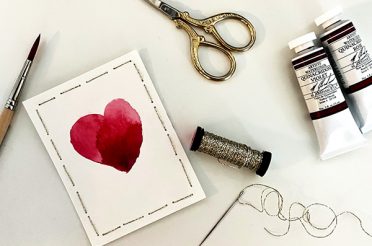If you’ve ever wondered why there seems to be different ways of forming a cross stitch, then this tutorial should help! This video will discuss the English method and the Danish method of forming stitches. I’ve had several comments in my beginners playlist of tutorial videos on YouTube that people weren’t sure if doing half the stitch first and then coming back was correct, or forming the stitch fully before moving onto the next cross stitch. Neither one is better than the other, and many stitchers (myself included) use both cross stitch techniques when stitching. It’s all about experimenting with both, and seeing which one works best for you most of the time. Do try moving vertically as well, sometimes stitchers find they prefer working up and down across a pattern (rather than horizontally as I’m showing in the video below).
English method
- Completing each cross at once
- This method is ideal for doing when you’re using the parking method of working across your pattern
- The English method also often the easier method to use when handling confetti stitches (random scattered stitches of one colour across your pattern)
Danish method
- Doing one half of the stitch in one direction, then coming back to do the other half of the stitch
- This method is ideal for working in big blocks of colour, as you can go in one direction then back (ending up at the beginning of the next row or column)
- The Danish method is perfect if you like using the sewing method, or sewing in hand without a hoop or a frame
When forming your cross stitch, it doesn’t matter which direction you go in first, as long as your top stitch is always going the same direction.
Links mentioned in the video
- Cross country stitching
- Parking method
- Sewing method
- Whether you should worry about what the back looks like










19 Responses
Lacy
Is there a name for us cross stitchers that flip front to back to front to back when stitching? I cannot for the life of me only view the front and trust my fingers to return the needle from the back of a piece to the correct little hole to the front. I have to flip and flip and flip. It would be helpful to know this technique when searching for “rotating frames.”
Thanks!
Dana Batho
Hi Lacy! There’s no “official” name that I know of, as most people learn how to not flip. I’d really recommend trying to learn to not do that — the reason is your projects are going to take so much longer to do (so you may lose motivation to finish), but more importantly you actually literally may create a RSI doing that, you may injure yourself if you’re flipping for every stitch. Try using fabric with bigger holes at first (like even 11 count Aida if that works for your projects), and get used to using your fingertips on the back to guide the needle to the front. There absolutely are frames that can flip (like the clamp stand I have, a Lowery stand), but they’re not meant to be flipped for every stitch as that can actually wear them out really fast, make the joints loose, etc as you’re constantly having to take the tension off and on to flip. So keep trying, don’t give up, you absolutely CAN do it. But yeah, you can easily end up hurting yourself in the long run by flipping each stitch, so do try and learn to work only from the front (and only flip if you get a knot or need to end your thread). 😊
Jena
what is the name of the cross stitch that when done the reverse it is blank..?
Dana Batho
Hi Jena! I’m not sure, I’m not sure what you’re referring to, there is no type of stitching that’s blank on the back, that’s not possible. 🙂
Juliana
Hello Jean… I think that you are referring to kind of stich called “vagonite” in Brazil.
Kathleen Carlson
I have a ÅRETS KORSSTING 1985 Danish directions for flower patterns, but I can’t decipher the stiches, amount of thread to get. There’s a curios chart in the back, but I don’t know how to read it. Please help me!
Dana Batho
Hi Kathleen! I’m sorry, I can’t help you — I’ve never heard of that company, and the Danish method I’m referring to in this post doesn’t have anything to do with actual Danish designs or patterns. I don’t know if the company still exists, but I’d try contacting them if they do — only the designer of that pattern or the company that produced it can help you unfortunately.
Kerry Senior
I’ve been cross stitching for a few years and never realised that there was English /Danish names for making each stitch.
I must admit that I use both ways of stitch making on every piece that I’ve ever done.
Dana Batho
Yep me too, I mix them around depending on where I’m working in a project. 🙂
Kristin
This fascinates me. For one, I had no idea anyone did it any differently THAN the “Danish method”- nor did I know that this “method” had a name! To work each cross stitch individually to me would be madness- very time consuming and tedious. The “parking” thing- also did not know it had it’s own name either. I often make use of that parking trick, there are so many methods, tips, tricks Ive used through the years, never learning it from anything but just using one’s own head & common sense when working a project, & I assumed everyone else worked the same as I!
I am glad I found this site, thank you. I am in US. It seems to me only the elderly people work cross stitches these days here, and from what I gather, the crafts such as this are more popular and enjoyed in UK and Japan more than in America. I don’t know it for a fact but it seems that way to me.
Dana Batho
Haha actually the English method isn’t really much slower than the Danish method, and you do need to stitch in that style for confetti stitches, etc (random stitches of a colour scattered across an area). And I know it seems like cross stitchers are mainly an older crowd, but lots of people in the US and elsewhere are younger and love it — they’re just into stitching very different patterns than the traditional ones (like Julie Jackson’s Subversive Cross Stitch designs are very popular among the younger crowd). I’m glad you enjoy the site Kristin, thanks for the feedback. 🙂
Elizabeth Murray
I use the Danish method but don’t do parking, just end of start a fresh. I like my backs to look reasonably neat too. This has been interesting to see that I thought I was doing it the English way but obviously not. Thank you for the tutorial.
Dana Batho
Haha that’s funny, I guess the old adage is true that you learn something new every day! Glad you enjoyed the tutorial Elizabeth, happy stitching! 🙂
Chris Arlington
In general I use the Danish method. If I work vertically I use the English method. If I use overdyed or variegated I use the English method. I’m picky about my backs, so I am not fond of parking. What can I say?
nglish method. For variegated threads I use the
Dana Batho
Haha perfect, whatever works best for you Chrissie! I don’t like parking either, it makes me nuts. 🙂
Audrey Archer
I generally use the Danish method, unless I am working with specialty threads – i.e., “variations”, “variegated”, “hand-dyed”, “space-dyed”, etc. But when using the English method, to keep the back “tidy”, I used to carry my needle across the back across the top & bottom, but that uses a LOT of thread; now I start every stitch coming up in the bottom left, stitch to top right, then carry on back to bottom right, stitch to top left, carry on back to bottom right again, which is the bottom left of the next stitch. The back ends up looking like this : |/|/|
Dana Batho
Nice, that sounds like a good method you’re doing Audrey! I may end up doing a separate mini-tutorial on using variegated threads, as doing the Danish method with them can end up with some “interesting” effects. 🙂
Amy Supple
I stitch in hand & use the English style as a designer I’m stitching was extremely fond of confetti. She also designed works that uses a lot of combining colors to make new colors for shading.
I can’t get back into the Dutch method when doing simpler patterns. I still stitch using the English method.
I’ve been stitching since 12 years old & now 50(ish) and I miss the large sections of patterns and materials that used to be available in stores. Now I’m lucky to find them in thrift stores or online only.
Dana Batho
Yes, online is the best way to find a range of patterns these days, for a number of reasons. A lot of smaller needlework shops are going out of business which reduces the amount of retail outlets a designer can sell in, and the big box stores have a lot of super generic kits and patterns. Even the existing smaller needlework stores, they often won’t take on any “different” designs because their target market tend to be an older clientele who are stuck in the style they like. Like my LNS has never asked who I distribute with, even though I’m in there all the time and they’ve seen my designs and really like them — it’s because the people who come into the shop are mostly tourists who want a certain style of pattern (which is not my style). Plus it’s often hard for new designers to even get distributed to the smaller retail shops, there are only a few distributors out there (and again, if your patterns don’t fit within a certain range of style, they may not pick up your designs at all). To do wholesale themselves directly to retail outlets is usually completely out of reach for most small designers, the costs and admin is prohibitive. So that’s why many newer designers sell online only — they can afford to sell and not lose money at it, even selling somewhere like Etsy, your profit margins are very small when you consider all the fees involved, especially as PDF patterns are inexpensive to begin with. 😊